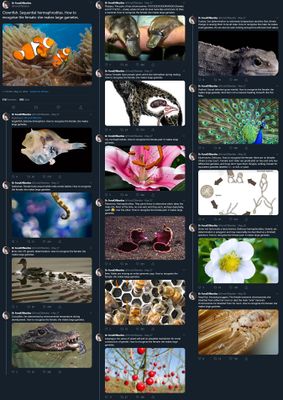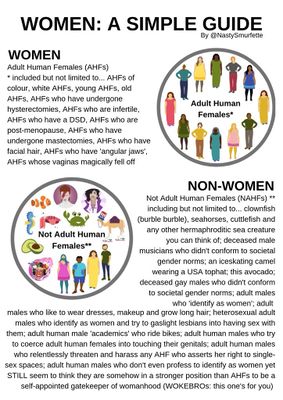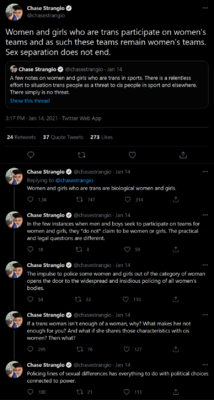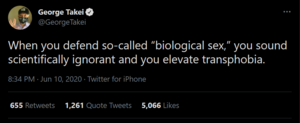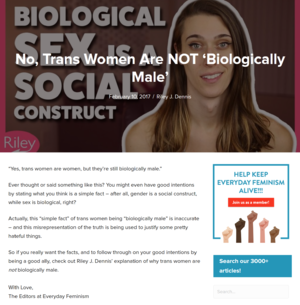Sex: Difference between revisions
Technician (talk | contribs) No edit summary |
Technician (talk | contribs) (Expand and improve.) |
||
| (6 intermediate revisions by 4 users not shown) | |||
| Line 1: | Line 1: | ||
'' | In biology, '''sex''' refers to the categorization of organisms (or their parts) with regard to the role they play in reproduction. When a species reproduces sexually, it usually does so by producing one of two types of gamete that have to come together to form a new member of the species. One type of gamete is large and non-mobile (ova), whereas the other type is small and motile (sperm). When an organism or an organ produces large and non-mobile gametes, it is called '''female'''. If it produces small and motile gametes, it is called '''male'''. | ||
== Sex in humans == | |||
In most mammals, in particular humans, female members of the species can be identified by having two X chromosomes, ovaries, a uterus and a vagina. The ovaries produce ova (also called egg cells), which may be fertilized | In most mammals, in particular humans, female members of the species can be identified by having two X chromosomes, ovaries, a uterus and a vagina. The ovaries produce ova (also called egg cells), which may be fertilized by a sperm to become a zygote. The zygote rapidly divides to form an blastocyst; this moves along the oviduct (fallopian tube) to the uterus where it becomes implanted in the uterine lining. In addition to the embryo proper, the fetal membranes and placenta are all formed from the cells of the blastocyst i.e. come from the zygote. The developing embryo develops into a fetus, and ultimately a baby which is brought to the world through the vaginal canal. Males can be identified by having an X and a Y chromosome, testes (testicles) and a penis. The testes produce sperm, which are ejaculated into the vagina during sexual intercourse, from where they might travel towards the ova to fertilize them. | ||
Some disorders may cause a person not to develop typical sex organs. The umbrella term [[intersex]] covers persons who show ambiguity in their sex due to such a disorder. | == Intersex == | ||
Some disorders may cause a person not to develop typical sex organs. The umbrella term [[intersex]] covers persons who show ambiguity in their sex due to such a disorder. Intersex is a disputed term, with some people preferring Differences (or Disorders) of Sex Development (DSDs). Only 0.018% of all new-borns have genitalia which are truly ambiguous, such babies used to have their sex assigned at birth (this is where the phrase originates) based on the "best guess" of the attending medics. Often this assignment would include surgery - Intersex Genital Mutilation (IGM). The sex in these rare cases is now determined after careful diagnostics tests, and any reassignment surgery is usually not performed until the individual can make informed consent. | |||
Some legal systems also classify people according to sex. Under such systems, a person's legal sex may not correspond to their biological sex, because of errors in documentation, or because of legal sex-change procedures that may be allowed for [[transgender]] or [[transsexual]] people. Some systems allow a third sex category for those who don't want to be legally identified as female or male, either because they have an intersex condition, or because they claim to have a [[gender identity]] that is [[non-binary]]. | Some legal systems also classify people according to sex. Under such systems, a person's legal sex may not correspond to their biological sex, because of errors in documentation, or because of legal sex-change procedures that may be allowed for [[transgender]] or [[transsexual]] people. Some systems allow a third sex category for those who don't want to be legally identified as female or male, either because they have an intersex condition, or because they claim to have a [[gender identity]] that is [[non-binary]]. | ||
== Denial by trans activists == | |||
Some [[transgender ideology|trans activists]] deny that biological sex is real, meaningful, or constrained to two sexes. While doing so, they often claim that their position is in fact scientifically proven. This is not a position that is only espoused by little-known trans activists online, but shared on large platforms by some leading trans activists and their allies. Examples include [[Wikipedia:ACLU|ACLU]] lawyer [[Wikipedia:Chase Strangio|Chase Strangio]], actor and activist [[Wikipedia:George Takei|George Takei]], and trans activist YouTuber [https://rationalwiki.org/wiki/Riley_Dennis Riley J. Dennis] who was featured on [[Everyday Feminism]] with his video ''Biological Sex is a Social Construct'' under the title [https://everydayfeminism.com/2017/02/trans-women-not-biologically-male/ ''No, Trans Women Are NOT 'Biologically Male''']. | |||
== Gallery == | |||
<gallery caption="Images (click to enlarge)" perrow=3 widths=300px heights=400px> | |||
File:Sex Explained by DrFondOfBeetles.jpg | A very long Twitter thread by @DrFondOfBeetles in which we see binary sex across a wide spectrum of species. | |||
File:Sex Explained by NastySmurfette.jpg | A handy graphic by @NastySmurfette which might further clear up your confusion. | |||
File:ChaseStrangioDenyingSex.png | Chase Strangio talking about how transwomen are biologically women and transmen are biologically men. | |||
File:GeorgeTakeiDenyingSex.png | George Takei is of the opinion that believing in biological sex makes you scientifically ignorant and transphobic. | |||
File:RileyDennisDenyingSex.png | [[Everyday Feminism]] talking about how transwomen are not biologically male, linking to Riley Dennis's video. | |||
</gallery> | |||
== Links == | == Links == | ||
| Line 13: | Line 29: | ||
* https://twitter.com/FondOfBeetles/status/1133120326844506112 | * https://twitter.com/FondOfBeetles/status/1133120326844506112 | ||
* https://twitter.com/NastySmurfette/status/1123635007615115264 | * https://twitter.com/NastySmurfette/status/1123635007615115264 | ||
* https://everydayfeminism.com/2017/02/trans-women-not-biologically-male/ | |||
<!-- Language links: --> | |||
[[pt:Sexo]] | |||
Latest revision as of 01:33, 28 April 2021
In biology, sex refers to the categorization of organisms (or their parts) with regard to the role they play in reproduction. When a species reproduces sexually, it usually does so by producing one of two types of gamete that have to come together to form a new member of the species. One type of gamete is large and non-mobile (ova), whereas the other type is small and motile (sperm). When an organism or an organ produces large and non-mobile gametes, it is called female. If it produces small and motile gametes, it is called male.
Sex in humans
In most mammals, in particular humans, female members of the species can be identified by having two X chromosomes, ovaries, a uterus and a vagina. The ovaries produce ova (also called egg cells), which may be fertilized by a sperm to become a zygote. The zygote rapidly divides to form an blastocyst; this moves along the oviduct (fallopian tube) to the uterus where it becomes implanted in the uterine lining. In addition to the embryo proper, the fetal membranes and placenta are all formed from the cells of the blastocyst i.e. come from the zygote. The developing embryo develops into a fetus, and ultimately a baby which is brought to the world through the vaginal canal. Males can be identified by having an X and a Y chromosome, testes (testicles) and a penis. The testes produce sperm, which are ejaculated into the vagina during sexual intercourse, from where they might travel towards the ova to fertilize them.
Intersex
Some disorders may cause a person not to develop typical sex organs. The umbrella term intersex covers persons who show ambiguity in their sex due to such a disorder. Intersex is a disputed term, with some people preferring Differences (or Disorders) of Sex Development (DSDs). Only 0.018% of all new-borns have genitalia which are truly ambiguous, such babies used to have their sex assigned at birth (this is where the phrase originates) based on the "best guess" of the attending medics. Often this assignment would include surgery - Intersex Genital Mutilation (IGM). The sex in these rare cases is now determined after careful diagnostics tests, and any reassignment surgery is usually not performed until the individual can make informed consent.
Some legal systems also classify people according to sex. Under such systems, a person's legal sex may not correspond to their biological sex, because of errors in documentation, or because of legal sex-change procedures that may be allowed for transgender or transsexual people. Some systems allow a third sex category for those who don't want to be legally identified as female or male, either because they have an intersex condition, or because they claim to have a gender identity that is non-binary.
Denial by trans activists
Some trans activists deny that biological sex is real, meaningful, or constrained to two sexes. While doing so, they often claim that their position is in fact scientifically proven. This is not a position that is only espoused by little-known trans activists online, but shared on large platforms by some leading trans activists and their allies. Examples include ACLU lawyer Chase Strangio, actor and activist George Takei, and trans activist YouTuber Riley J. Dennis who was featured on Everyday Feminism with his video Biological Sex is a Social Construct under the title No, Trans Women Are NOT 'Biologically Male'.
Gallery
- Images (click to enlarge)
Everyday Feminism talking about how transwomen are not biologically male, linking to Riley Dennis's video.
